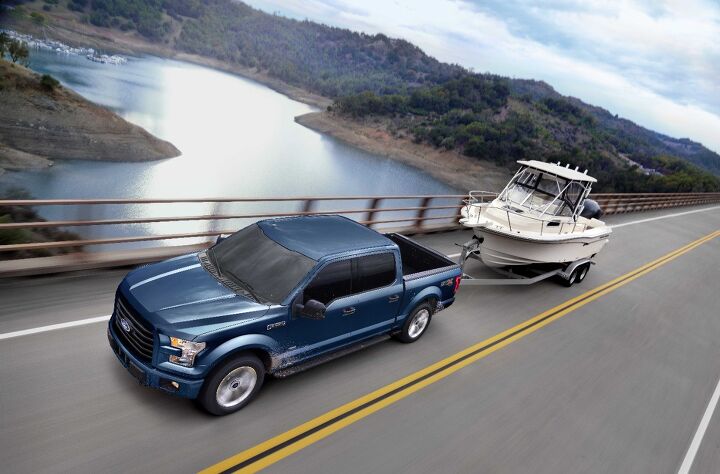Ford Piles on the Tech, Squeezes More Mileage From the 2017 F-150

It’s not a revolution in fuel efficiency, but an evolution.
Ford added a healthy dose of new technology to the 2017 F-150’s 3.5-liter Ecoboost V6 powertrain, but the significance of the newfound efficiency depends on who you ask. To the folks at the Blue Oval, it’s a mileage boost worthy of celebration. To would-be buyers, it’s a minor perk, but tell me more about the torque.
We’ve already detailed the improvements made to the next-generation 3.5-liter Ecoboost. Producing 375 horsepower and 470 foot-pounds of torque, the revised mill makes many V8s envious. The added power comes by way of a dual direct and port fuel-injection system that sends fuel to both the intake port and cylinder, turbochargers with lighter turbine wheels and electrically activated wastegates.
Adding to the efficiency, Ford paired the engine with its new 10-speed automatic transmission, a unit co-developed by the automaker and General Motors.
What’s the payoff? A solitary mile per gallon. Ford rates rear-wheel-drive F-150 models equipped with the engine at 18 mpg in the city and 25 mpg on the highway, or 21 mpg combined. That’s an increase of 1 mpg in all three categories.
Four-wheel-drive models return 17 city/23 hwy/20 combined, or an overall gain of 2 mpg.
Compared to the base V6 engines of its domestic competition, the rear-drive Ecoboost-powered F-150 matches the highway mileage of the 3.6-liter Ram 1500 (4×2 model), but beats its city mileage by 1 mpg. Ford matches the 4.3-liter Chevrolet Silverado 1500 4×2’s mileage in the city, but beats its highway figure by 1 mpg.
Modest gains if you’re only looking at displacement, not output. That Ford could wring any mileage improvement out of the engine while delivering a significant power boost is admirable.
Within its own stable, the new powertrain’s combined mileage beats the naturally aspirated 3.5-liter F-150 by 1 mpg, and falls 1 mpg short of the 2.7-liter Ecoboost’s combined figure.
[Image: Ford Motor Company]

More by Steph Willems
Latest Car Reviews
Read moreLatest Product Reviews
Read moreRecent Comments
- Bkojote Allright, actual person who knows trucks here, the article gets it a bit wrong.First off, the Maverick is not at all comparable to a Tacoma just because they're both Hybrids. Or lemme be blunt, the butch-est non-hybrid Maverick Tremor is suitable for 2/10 difficulty trails, a Trailhunter is for about 5/10 or maybe 6/10, just about the upper end of any stock vehicle you're buying from the factory. Aside from a Sasquatch Bronco or Rubicon Jeep Wrangler you're looking at something you're towing back if you want more capability (or perhaps something you /wish/ you were towing back.)Now, where the real world difference should play out is on the trail, where a lot of low speed crawling usually saps efficiency, especially when loaded to the gills. Real world MPG from a 4Runner is about 12-13mpg, So if this loaded-with-overlander-catalog Trailhunter is still pulling in the 20's - or even 18-19, that's a massive improvement.
- Lou_BC "That’s expensive for a midsize pickup" All of the "offroad" midsize trucks fall in that 65k USD range. The ZR2 is probably the cheapest ( without Bison option).
- Lou_BC There are a few in my town. They come out on sunny days. I'd rather spend $29k on a square body Chevy
- Lou_BC I had a 2010 Ford F150 and 2010 Toyota Sienna. The F150 went through 3 sets of brakes and Sienna 2 sets. Similar mileage and 10 year span.4 sets tires on F150. Truck needed a set of rear shocks and front axle seals. The solenoid in the T-case was replaced under warranty. I replaced a "blend door motor" on heater. Sienna needed a water pump and heater blower both on warranty. One TSB then recall on spare tire cable. Has a limp mode due to an engine sensor failure. At 11 years old I had to replace clutch pack in rear diff F150. My ZR2 diesel at 55,000 km. Needs new tires. Duratrac's worn and chewed up. Needed front end alignment (1st time ever on any truck I've owned).Rear brakes worn out. Left pads were to metal. Chevy rear brakes don't like offroad. Weird "inside out" dents in a few spots rear fenders. Typically GM can't really build an offroad truck issue. They won't warranty. Has fender-well liners. Tore off one rear shock protector. Was cheaper to order from GM warehouse through parts supplier than through Chevy dealer. Lots of squeaks and rattles. Infotainment has crashed a few times. Seat heater modual was on recall. One of those post sale retrofit.Local dealer is horrific. If my son can't service or repair it, I'll drive 120 km to the next town. 1st and last Chevy. Love the drivetrain and suspension. Fit and finish mediocre. Dealer sucks.
- MaintenanceCosts You expect everything on Amazon and eBay to be fake, but it's a shame to see fake stuff on Summit Racing. Glad they pulled it.


































Comments
Join the conversation
UN-BAN BIGTRUCKS@YOUTUBE!!!!
Yet another well intentioned yet completely failed effort by Ford. All the tech, all the beer cans, all the unnecessary complication and these trucks really have no significant improvement over their competition. Once again all hype and no results. And that 2.7 is a hateful engine. It's garbage. It makes a noise reminiscent of a 3.0L Ford Windstar and really delivers no real world advantage over the proper 5.0L. Ford really needs to recruit some decent engineers to figure this stuff out. Then they would have actual results and wouldn't need such a big marketing department.